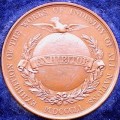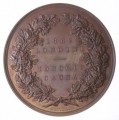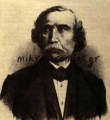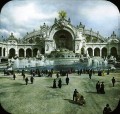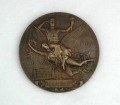Corfu in the International Exhibitions and the Olympics in the 19th century
Since the mid-19th century the International Exhibitions (Expositions Universelles) have already become an institution in the big European capitals. These exhibitions had an international interest and all countries participated in them. The variety of the exhibits was not limited to trade goods, but one could say that a country was represented in its entirety. Sporting events, speeches, theatrical plays, art and photography exhibitions etc. were held. Greek representation was organized by province by the so-called Prefectural Committees. They would record the entries, take care of the collection of the exhibits, their proper packaging and their dispatch to Athens, where the central commission was seated. From there they would be sent to the city that hosted the Exhibition. They were also responsible for the return of the exhibits to Greece. One can say that Pier de Coubertin was inspired by these Exhibitions for the revival of the Olympic Games.
The most notable Exhibitions, in which Corfu participated, were:
The Great Exhibition, 1851, London
The first international exhibition took place in Crystal Palace, which was built in Hyde Park.
In the Great Exhibition of 1851 in London, Corfu participated as a state of the “United States of the Ionian Islands”. Its participation was insignificant, which is proven also by the catalogue of the exhibits, which includes just olive oil and some small jewelry.
The prizes awarded in the Great Exhibition
British protectorate and the Ionian Government were heavily criticized for not exploiting the opportunity to present the products and works of art of the Ionian Islands in the Exhibition in a bigger and more effective way.
International Exhibition 1862, London
Because of its previous accusations the Protectoral Government made a pompous effort to present the products of the Ionian islands in this Exhibition in a special way.
In that effort, the “Ionian Company”, which registered merchants, tradesmen, artists and other professionals from the Ionian Islands as its members, was founded then. The members of the company contributed money and their products to it. Many donations were also given to the company, most notably the one from honored vice-president of the company, Evangelos Zappas, Greek benefactor and founder of the “Zappas Olympics”. (More information on the “Zappas Olympics” below). There was also a great contribution from the State Treasury of the Ionian Islands. As a result of all the above mentioned, the company raised more than 15.000 drachmas.
Before the international exhibition the company organized the ESPOSIZIONE JONIA, a domestic exhibition in Corfu on 20th January 1862.
The publication in IONIKI EFIMERIDA for the Ionian Exhibition.
Announcement of a short postponement of the domestic exhibition in the Newspaper of the Ionian Islands (1/1/1862).
In this (test) exhibition, for which large amounts of money were spent, the finest exhibits of Corfu were collected under the influence of some members of the commission and were handed to the founder and vice-president of the commission, Secretary of the Commissioner, Drummond Wolff.
The medal awarded to the winners in the Ionian exhibition 1862:
“AΩΞB. IONIOΣ EKΘEΣIΣ. TEXNH TΥXHN EΣTEΡΞE KAI TΥXH TEXNHN”
Drummond Wolff ordered the transportation of the exhibits in London and they were displayed in the International Exhibition.
Many from the Corfiot exhibitors were presented with medals (medallions), honors and prizes.
Medals awarded to prize winners in the international exhibition in London, 1862
The corfiot exhibits awarded with a prize were: olive oil, wine, canvas works, jewelry, fabrics, needlework, furniture, works of art, engravings, collections of birds and other animals, minerals and plants.
All this proved that the land was productive and its people clever and handy, but they lacked in[1] technical and scientific knowledge. This is proven also by the people that were awarded a prize. Here it should be noted that the English Protectorate didn’t put enough effort so that the Ionian people had the industrial and agricultural means that the English people enjoyed, and that led to their progress and prosperity.
The Corfiots that were awarded with a prize and their products are listed below.
The exhibition of the Corfiot products in London brought the potential of the island at that time to light.
We publish all relevant issues of the official Ionian Newspaper about this international exhibition, where the products of the Ionian Islands that were awarded a prize are listed and presented.
Almost a year later, on 30/3-11/4 1863 the official newspaper of the United States of the Ionian Islands commented on the success of the Ionian products and compared the prizes that were awarded to them to those awarded to products of other developed countries.
International Exhibition 1867, Paris
Corfu, as a member of the Kingdom of Greece this time, sent only few products to this exhibition, due to the shortage of money and the civil wars that troubled Greece. These two reasons led to the agriculture and industry being neglected, which were, and still are, considered to be prosperity factors for a nation. Truth is that the productivity of the Corfiots has been neglected and there were not enough initiatives for development given.
Although there were many international exhibitions that took place in the following years, Corfu wasn’t presented in detail in any of them.
“Olympia”
The so-called “Zappas Olympics”, or “Olympia”, a series of commerce and athletic events, were organized four times before the revival of the Olympic Games (1859, 1870, 1875 and 1888).
(*) At around 1840 Evangelos Zappas, inspired by the poem “Dialogue of the Dead” by Panagiotis Soutsos, suggested to the Greek government to undertake the funding of the modern Olympic Games himself, with the amount of 400,000 golden pounds or 1 million golden francs. His dream was “seeing Greece developing into a powerful and robust country, worth of its past glory and able to strengthen and retain all the dispersed Greeks. The only way to achieve this purpose is through the revival of the ancient Olympic Games”. In 1857 the Greek government accepted the offer and the then Minister of Foreign Affairs, Alexandros Rizos-Rangavis, proposed the organization of a mixed event, that would include an agricultural and industrial exhibition, as well as a series of athletic events.
Zappas accepted the offer and in order to ensure the financing of the Games, he offered to the government 400 shares of a shipping company and the profit he gained from them. On 28th August 1858 the Royal Decree “On the establishment of Olympia” was published, according to which general exhibitions under the name “Olympia” were to take place in Athens every 4 years and in which all Greek products, especially the industrial, agricultural and stock farming products shall be presented. On the 30th September 1858 the law “On the establishment of the Olympic Games” was drafted and published. In the relevant Royal Decree Otto appeared as the founder of the “Olympia” and Zappas as the agonothetes, while the Games were to take place during the period between the first and the last Sunday of October 1859. In the following 30 years, 4 Olympiads took place, in the years 1859, 1870 and 1875. The opening ceremony of the “Olympia” took place in the premises of the Technical University on Piraeus street on 18th October 1859.
(*)Livepedia: http://www.livepedia.gr/index.php/Ζάππας_Ευάγγελος#.CE.96.CE.AC.CF.80.CF.80.CE.B5.CE.B9.CE.B5.CF.82_.CE.9F.CE.BB.CF.85.CE.BC.CF.
80.CE.B9.CE.AC.CE.B4.CE.B5.CF.82_.7FUNIQ6cea3d4f1665f703-nowiki-00000004-QINU.7F2.7FUNIQ6cea3d4f1665f703-nowiki-
According to his will, Zappeion Hall was to be built in Athens, which finally opened in 1888.
Read more:
http://www.sansimera.gr/almanac/1806#ixzz2hJtfdTcl
For more information on the Games of 1870 we provide the following article:

The wooden building of Zappeion Hall, on the junction of today’s Vasilissis Amalias and Vasilissis Olgas avenues, where the 2nd and 3rd Olympia took place.
Written by Eleftherios g. Skiadas
The next Zappas Olympics, however, didn’t take place after 4 years, as expected. The political developments led to the overthrow of Otto in 1862 and the ascent of Danish George I to the Greek throne a year later. In 1865 Evangelos Zappas passed away. Zappas Olympics took place again later, in 1870, with big success this time. About 20000 people filled both sides of the Panathenaic Stadium. In the meantime, excavations had been made that revealed the full extent of the stadium.
The management committee of Zappas’ endowment, with Dimitrios Christidis as its vice-president and most notable personality, was in charge of the whole effort. The planning of the athletic part of the event was assigned to German Jules Henning, former officer of Otto, which still remained in Athens after Otto’s overthrow and worked as music and physical education teacher in the Arsakeio High School and the Athens Conservatoire. He worked in cooperation with physical education instructor Daniil Tziotis, while university professors Philippos Ioannou, Konstantinos Vousakis and Grigorios Pappadopoulos also helped, in that they compiled the regulations of the different sport competitions on the model of the ancient Olympic Games.
Medal given to the winners at the 2nd Olympia. Engraved by Barre and cut at the French Mint. On one side the head of King George I is pictured and on the other side the phrase “Agonothetes Evangelos Zappas – Olympia – Athens 1870” is embossed.
A detailed program of the “Nude Games” was issued. The obligatory training of the athletes for 45 days and their uniform clothing was established. The athletes that would compete lined up facing the crowd and the authorities, a religious ritual followed and the first Olympic anthem was heard, with lyrics by Orphanidis and music by Parisinis.
Then followed the oath of the athletes:
“I pledge to compete honorably, respecting and abiding by the rules and with respect to my competitors” (newspaper Proinos Kyrix, 21 November 1870). The events of diaulos, triple jump, long jump, wrestle, discus throw, javelin throw, pole vault and rope climbing took place. Medals engraved by French engraver Barre and cut at the French Mint were given to the winners. The head of the new Monarch was engraved on the one side, while on the other side the phrase “Agonothetes Evangelos Zappas – Olympia – Athens 1870” was embossed in his memory. Apart from the athletics, equestrian, shooting, rowing and swimming events were also to take place at the Phaleron bay. They were cancelled, however, because they were postponed till November, which was not suitable for such sports.
Dimitrios Christidis served as vice-president of the Committee for Olympia and Zappas’ endowment.
One of the program objectives of the Zappa’s endowment committee for these games was the so-called “worship of the Muses”, the emphasis on the arts. Awards for sculpture, painting, architecture, writing and music were established. In the exhibition in Zappeion Hall paintings of the Zakynthians Tsokos and Kalyvokas and Lytras and Gyzis from the island of Tinos were going to be on display, as well as seascapes by Volanakis. The “Poetry Games” also proved to be of great success, where 11 dramatic and 9 lyric poems competed. The first award, a golden wreath, was given to Angelos Vlachos, although it is not known for which work of his.
According to the press reports at that time, the Games were a big success, as nothing went wrong. The event was even called a national celebration.
In 1870 the Central Committee invited Corfu to participate with the other prefectures of the Kingdom of Greece, in order to gain the benefits that the Zappas’ endowment provided to the contestants.
Despite the big difficulties the event was faced with, it was imperative for Corfu to participate, in order for the whole of Greece and the visitors to see the potential each prefecture had and get to know their products. This way both sides had something to gain.
The visitors at the Olympia could see the flag of the Municipality of Corfu with the name of Evangelos Zappas embroidered on it, which was made by the Girls’ School in Corfu, a branch of the Society for the Promotion of Education and Learning in Athens.
The “Agios Spyridon” High School, which after the union of Corfu with the Kingdom of Greece replaced the costly Ionian High School, had a kiosk where liberal arts exhibits were on display. The exhibits were not common and had therefore a special value.
The exhibits about the houses and clothing of the island were visited by all those who were interested in the progress of the industry. All different kinds of brushes that were made in a poor craftsman’s small workshop could easily be compared to those made abroad.
The vigil light made by farmer Georgios Aulonitis draws admiration due to the patience and the prowess of the self-taught craftsman who didn’t work with professional tools.
Worth-mentioning were the self-made desks and the works of art made of bones by the prisoners in the Prison of Corfu.
The Corfiot pottery was inferior to pottery made in other parts of the country but it illustrated the progress there has been made in the until-then neglected pottery industry. For that reason the shop/workshop “Corfu” should be congratulated, which opened prior to the exhibition and aimed at the perfection of the pottery making techniques, as well as Spyridon Nerantzis, who opened a similar shop/workshop with his money.
In the field of needlework, it was impossible for the talent of young Corfiot girls to go unnoticed, which was also obvious in the sound competition of the needlework-shops in Corfu. Through their occupation with needlework, the girls were educated, and as a result the education level of the society rose.
The exhibits of the Corfiot producers of hats and wigs, the denture made of rubber by dentist Viscontis, the unfinished shoes, as well as those made by the prisoners for the soldiers, the pieces of silver-gold smithery, including the gold snake-shaped bracelet by skilful and efficient goldsmith Panagiotis Pandis that won a distinction, and lastly the travel chests, were an evidence of the potential and the progress of the island.
There is evidence that Corfu won several distinctions for its collection of agricultural and sea products, but not only for that. Distinctions were won by the brass, which was very useful for the households and the church, the table with legs of cast iron, the collection of embalmed birds and animals, like fox, jackal and dog, the chemical and industrial products, the kernel oil which was produced in the shop of Lamprou and Damianou company, under the care of chemist Delviniotis, and in the shop of Dimoulitsas. Moreover the wax, soap, fire-starters made of phosphorus, the varnish, drugs, carbonated water, lavender, cologne, salt, finished leather from cow and calf leather fabricated in the factory of manufacturer Mpoletsis that could easily be compared to those made abroad, the stearin that is obtained from the liquid mixture that’s left after the extraction of olive oil (sediment, dregs), and the petrified animal parts that have undergone chemical treatment, works of professor of chemistry and physics in the Ionian University, Delviniotis. All the above proved to everybody that Corfiots, while enjoying the benefits of science and art, had started being active in many fields, while also taking care of the industrial progress.
Apart from the above mentioned, though, we should also speak about some other notable exhibits: the almost four horsepower steam engine that was manufactured by Stylianos Kokotos, a remarkable work, when one takes into consideration that he lacked in the necessary equipment and knowledge.
Furthermore, the biscuits, waffles, spaghetti, etc. that were produced with the help of the steam engines, manufactured by Dimitris Zalikis, who worked day and night for the development of this industry.
Tsalikis’ windmill behind the municipal theater. (The picture dates to the middle of the last decade of 19th century, as the open space reveals, which nowadays is covered by the facilities of the gymnastic club of Corfu and by the “cupola” of the old municipal theater)
The plinths, mural painting tools, the olive oil, the rose liqueur, the wines, the alcoholic beverages and the beer were being improved every day so that they could stand equally next to the products of the other countries.
Lastly, we should mention two more accomplishments of the Corfiots, evidence of the Corfiot skillfulness: the presentation of a prototype motor vessel and the agronomy book, which was very useful for the development of the neglected agriculture.
Source: I KERKYRA EN TI TON OLYMPION EKTHESEI, 1870, V.P.X., Corfu, printing office: CORFU
Gerasimos Aspiotis and the International Exhibitions
Before he founded the playing-card factory in 1873, Gerasimos Aspiotis was working as an employee at the Municipality of Corfu. In 1872 he received the following letter from the Prefect:
With the above letter of 1872 he was appointed by the Prefect as secretary of the Prefectural Commission for the International Exhibition that was going to take place in Vienna. He was also given the responsibility to receive all files from the previous exhibitions as well as those for the future ones, which were going to take place in Paris and in Athens.
From this letter we can assume that Corfu most probably participated in the exhibition in Vienna in 1873, although there is no other evidence to prove that.
Prefect’s thanks for the good preparation for the Exhibition.
Prefect’s invitation to Aspiotis to undertake the preparations for the Olympia 1875.
The sticker put by the domestic commission on every box sent to the Central Committee.
The medal awarded in the exhibition of 1875
The above pictured official ceremony took place in 1876 in the presence of the exhibitors. As proven by the above pictured catalogue things went well for Corfu in this exhibition.
In 1877 Aspiotis again receives a letter by the Prefect concerning the exhibition in Paris in 1878.


 Efimerida ton Sizitiseon 6/5/1878
Efimerida ton Sizitiseon 6/5/1878
In 1888 Corfu participated in the 4th Olympiad. This Olympiad was of big importance, because the Zappeion Hall had been completed and the opening ceremony would coincide with the opening of the Hall. Therefore it would be done with much pomp and circumstance. The responsibility of the Corfiot exhibits was once again given to Gerasimos Aspiotis.
A large crowd attends the opening of the Zappeion Hall.
The last exhibition appointed to Aspiotis was the one in 1900.
All the above give us a picture of the financial life of the island in the second part of the 19th century, the efforts for its development, as well as the active character of its inhabitants.





